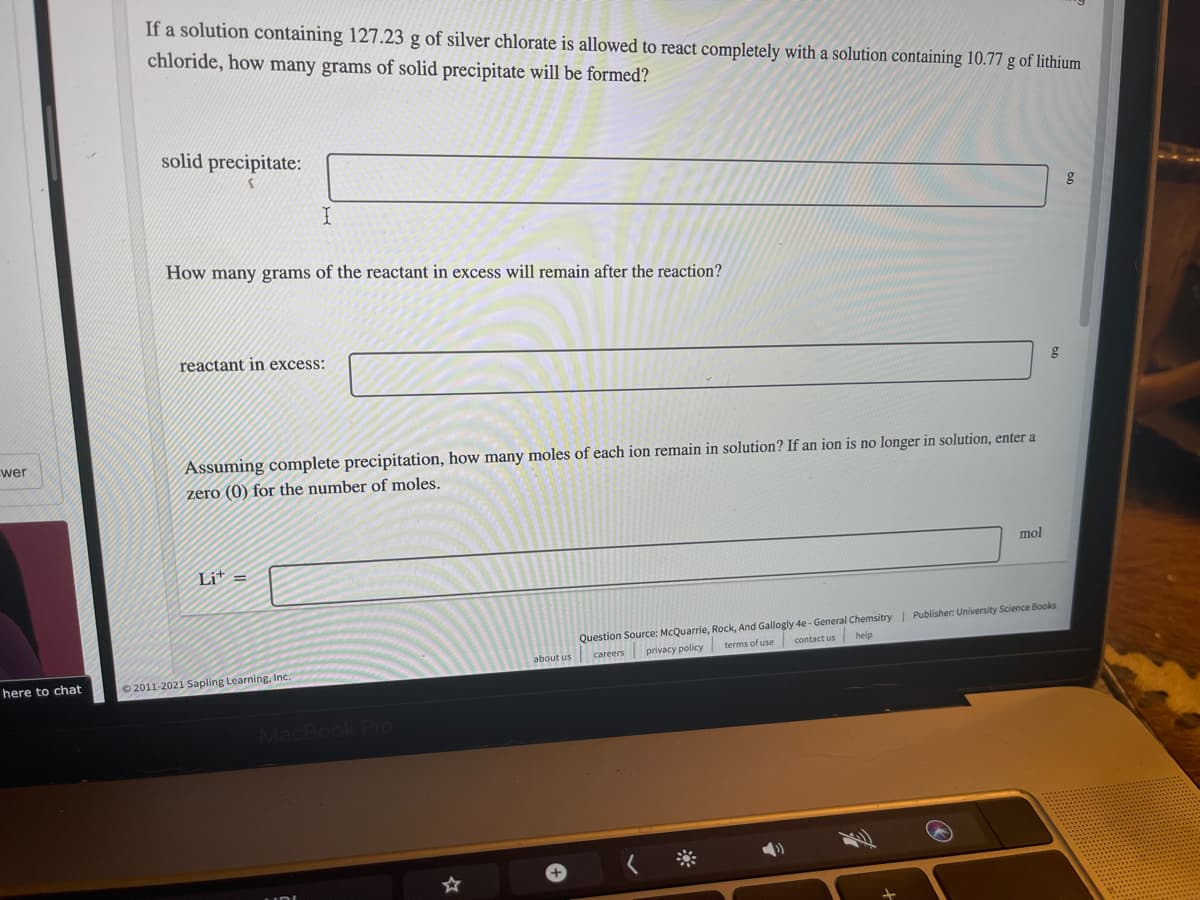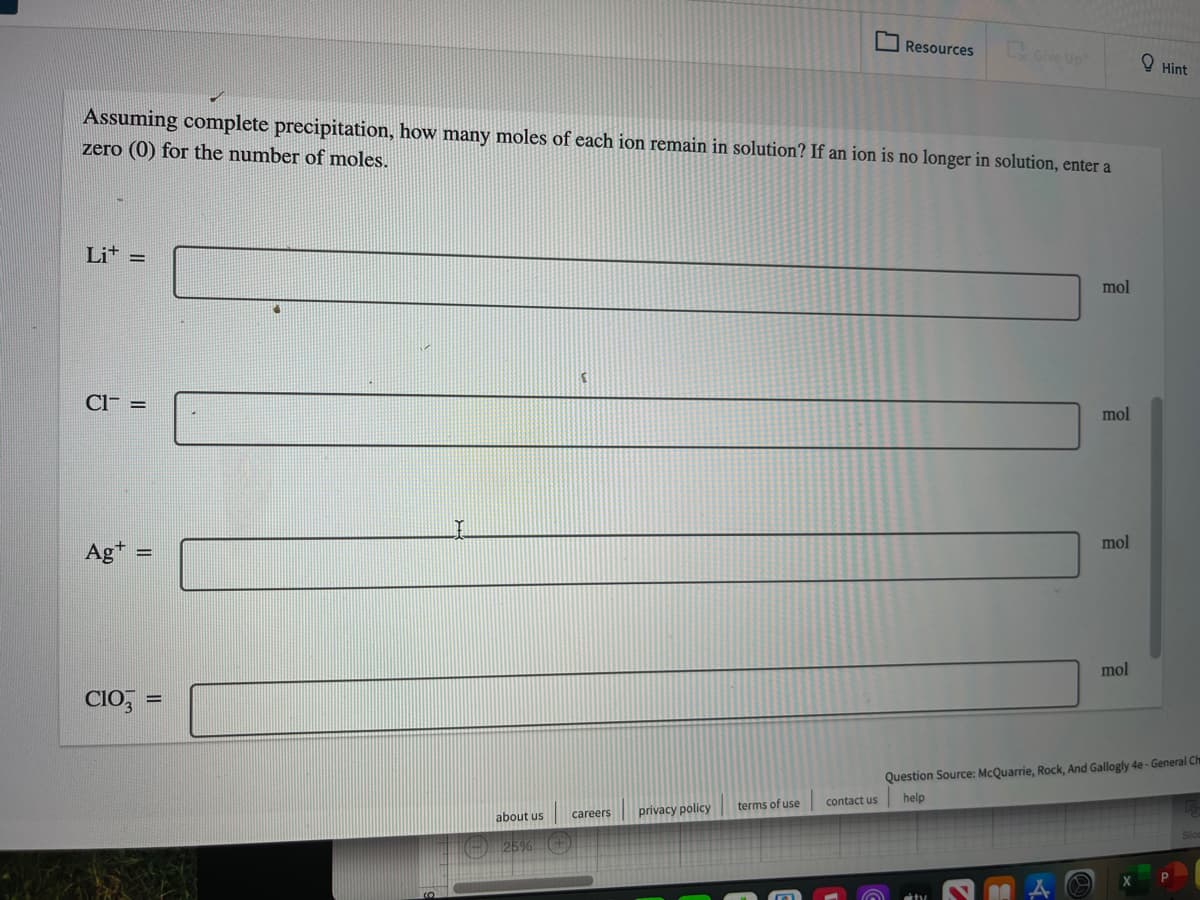If a solution containing 127.23 g of silver chlorate is allowed to react completely with a solution containing 10.77 g of lithium chloride, how many grams of solid precipitate will be formed? solid precipitate: How many grams of the reactant in excess will remain after the reaction? reactant in excess: Assuming complete precipitation, how many moles of each ion remain in solution? If an ion is no longer in solution, enter a zero (0) for the number of moles. mol Lit = | Publisher: University Science Books
If a solution containing 127.23 g of silver chlorate is allowed to react completely with a solution containing 10.77 g of lithium chloride, how many grams of solid precipitate will be formed? solid precipitate: How many grams of the reactant in excess will remain after the reaction? reactant in excess: Assuming complete precipitation, how many moles of each ion remain in solution? If an ion is no longer in solution, enter a zero (0) for the number of moles. mol Lit = | Publisher: University Science Books
Introductory Chemistry: A Foundation
9th Edition
ISBN:9781337399425
Author:Steven S. Zumdahl, Donald J. DeCoste
Publisher:Steven S. Zumdahl, Donald J. DeCoste
Chapter9: Chemical Quantities
Section: Chapter Questions
Problem 43QAP: Consider the equation: 2A+B5C. If 10.0 g of A reacts with 5.00 g of B. how is the limiting reactant...
Related questions
Question
How do I solve the problem?

Transcribed Image Text:If a solution containing 127.23 g of silver chlorate is allowed to react completely with a solution containing 10.77 g of lithium
chloride, how many grams of solid precipitate will be formed?
solid precipitate:
I
How many grams of the reactant in excess will remain after the reaction?
reactant in excess:
wer
Assuming complete precipitation, how many moles of each ion remain in solution? If an ion is no longer in solution, enter a
zero (0) for the number of moles.
mol
Lit =
Question Source: McQuarrie, Rock, And Gallogly 4e - General Chemsitry | Publisher: University Science Books
contact us help
about us careers privacy policy terms of use
here to chat
O 2011-2021 Sapling Learning, Inc.
Rook Pro

Transcribed Image Text:Resources
Give Up
O Hint
Assuming complete precipitation, how many moles of each ion remain in solution? If an ion is no longer in solution, enter a
zero (0) for the number of moles.
Lit =
mol
Cl- =
mol
mol
Ag*
%3D
mol
CIO, =
%3D
Question Source: McQuarrie, Rock, And Gallogly 4e - General Ch
help
contact us
terms of use
careers
privacy policy
about us
) 25%
Expert Solution
This question has been solved!
Explore an expertly crafted, step-by-step solution for a thorough understanding of key concepts.
This is a popular solution!
Trending now
This is a popular solution!
Step by step
Solved in 4 steps with 4 images

Knowledge Booster
Learn more about
Need a deep-dive on the concept behind this application? Look no further. Learn more about this topic, chemistry and related others by exploring similar questions and additional content below.Recommended textbooks for you

Introductory Chemistry: A Foundation
Chemistry
ISBN:
9781337399425
Author:
Steven S. Zumdahl, Donald J. DeCoste
Publisher:
Cengage Learning

World of Chemistry, 3rd edition
Chemistry
ISBN:
9781133109655
Author:
Steven S. Zumdahl, Susan L. Zumdahl, Donald J. DeCoste
Publisher:
Brooks / Cole / Cengage Learning

Chemistry for Engineering Students
Chemistry
ISBN:
9781337398909
Author:
Lawrence S. Brown, Tom Holme
Publisher:
Cengage Learning

Introductory Chemistry: A Foundation
Chemistry
ISBN:
9781337399425
Author:
Steven S. Zumdahl, Donald J. DeCoste
Publisher:
Cengage Learning

World of Chemistry, 3rd edition
Chemistry
ISBN:
9781133109655
Author:
Steven S. Zumdahl, Susan L. Zumdahl, Donald J. DeCoste
Publisher:
Brooks / Cole / Cengage Learning

Chemistry for Engineering Students
Chemistry
ISBN:
9781337398909
Author:
Lawrence S. Brown, Tom Holme
Publisher:
Cengage Learning

Chemistry: The Molecular Science
Chemistry
ISBN:
9781285199047
Author:
John W. Moore, Conrad L. Stanitski
Publisher:
Cengage Learning

Chemistry
Chemistry
ISBN:
9781305957404
Author:
Steven S. Zumdahl, Susan A. Zumdahl, Donald J. DeCoste
Publisher:
Cengage Learning

Chemistry: An Atoms First Approach
Chemistry
ISBN:
9781305079243
Author:
Steven S. Zumdahl, Susan A. Zumdahl
Publisher:
Cengage Learning